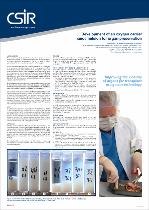JavaScript is disabled for your browser. Some features of this site may not work without it.
- ResearchSpace
- →
- Research Publications/Outputs
- →
- Conference Publications
- →
- View Item
| dc.contributor.author |
Barnard, A

|
|
| dc.contributor.author |
Msomi, S

|
|
| dc.contributor.author |
Moolman, S

|
|
| dc.contributor.author |
Naidoo, Kersch

|
|
| dc.date.accessioned | 2010-08-31T07:11:07Z | |
| dc.date.available | 2010-08-31T07:11:07Z | |
| dc.date.issued | 2010-08-31 | |
| dc.identifier.citation | Barnard, A, Msomi, S, Moolman, S and Naidoo, K. 2010. Development of an oxygen carrier nanoemulsion for organ preservation. CSIR 3rd Beinnual Conference 2010, Science Real and Relevant, CSIR International Convention Center, Pretoria, South Africa, p 1 | en |
| dc.identifier.uri | http://hdl.handle.net/10204/4222 | |
| dc.description | CSIR 3rd Beinnual Conference 2010, Science Real and Relevant, CSIR International Convention Center, Pretoria, South Africa | en |
| dc.description.abstract | The current key development focus in organ preservation for transplant purposes is preservation of organs at normothermic or subnormothermic temperatures (i.e at or slightly below physiological temperature) as opposed to cold storage. The current gold standard in organ preservation for transplant is to preserve harvested organs at low temperatures while circulating an organ preservation solution through the organ. The organs however, sustain some damage when exposed to such low temperatures, a phenomenon known as ‘cold perfusion damage’. It is therefore desirable to transport the organ at temperatures closer to normal physiological conditions (i.e 25 to 37 °C). This however, substantially increases the organ’s oxygen requirement levels. A critical aspect of organ preservation at higher temperatures is thus the provision of a sufficient oxygen supply to the harvested organ so that the organ can maintain its metabolic rate and remain a viable candidate for transplant. The CSIR has developed a synthetic perfluorocarbon (PFC) based nanoemulsion that serves as an oxygen carrier for the preservation of organs. Perfluorochemicals can be used as oxygen carriers due to their exceptionally high capacity to dissolve gasses1,2. Additionally, PFC’s display high levels of chemical stability and biological inertness which makes them suitable for biological use1,2. Perfluorooctyl bromide (PFOB) is the particular PFC used in the CSIR oxygen carrier emulsion1,2. | en |
| dc.language.iso | en | en |
| dc.publisher | CSIR | en |
| dc.subject | Oxygen carrier | en |
| dc.subject | Nanoemulsion | en |
| dc.subject | Organ preservation | en |
| dc.subject | CSIR Conference 2010 | en |
| dc.title | Development of an oxygen carrier nanoemulsion for organ preservation | en |
| dc.type | Conference Presentation | en |
| dc.identifier.apacitation | Barnard, A., Msomi, S., Moolman, S., & Naidoo, K. (2010). Development of an oxygen carrier nanoemulsion for organ preservation. CSIR. http://hdl.handle.net/10204/4222 | en_ZA |
| dc.identifier.chicagocitation | Barnard, A, S Msomi, S Moolman, and Kersch Naidoo. "Development of an oxygen carrier nanoemulsion for organ preservation." (2010): http://hdl.handle.net/10204/4222 | en_ZA |
| dc.identifier.vancouvercitation | Barnard A, Msomi S, Moolman S, Naidoo K, Development of an oxygen carrier nanoemulsion for organ preservation; CSIR; 2010. http://hdl.handle.net/10204/4222 . | en_ZA |
| dc.identifier.ris | TY - Conference Presentation AU - Barnard, A AU - Msomi, S AU - Moolman, S AU - Naidoo, Kersch AB - The current key development focus in organ preservation for transplant purposes is preservation of organs at normothermic or subnormothermic temperatures (i.e at or slightly below physiological temperature) as opposed to cold storage. The current gold standard in organ preservation for transplant is to preserve harvested organs at low temperatures while circulating an organ preservation solution through the organ. The organs however, sustain some damage when exposed to such low temperatures, a phenomenon known as ‘cold perfusion damage’. It is therefore desirable to transport the organ at temperatures closer to normal physiological conditions (i.e 25 to 37 °C). This however, substantially increases the organ’s oxygen requirement levels. A critical aspect of organ preservation at higher temperatures is thus the provision of a sufficient oxygen supply to the harvested organ so that the organ can maintain its metabolic rate and remain a viable candidate for transplant. The CSIR has developed a synthetic perfluorocarbon (PFC) based nanoemulsion that serves as an oxygen carrier for the preservation of organs. Perfluorochemicals can be used as oxygen carriers due to their exceptionally high capacity to dissolve gasses1,2. Additionally, PFC’s display high levels of chemical stability and biological inertness which makes them suitable for biological use1,2. Perfluorooctyl bromide (PFOB) is the particular PFC used in the CSIR oxygen carrier emulsion1,2. DA - 2010-08-31 DB - ResearchSpace DP - CSIR KW - Oxygen carrier KW - Nanoemulsion KW - Organ preservation KW - CSIR Conference 2010 LK - https://researchspace.csir.co.za PY - 2010 T1 - Development of an oxygen carrier nanoemulsion for organ preservation TI - Development of an oxygen carrier nanoemulsion for organ preservation UR - http://hdl.handle.net/10204/4222 ER - | en_ZA |






